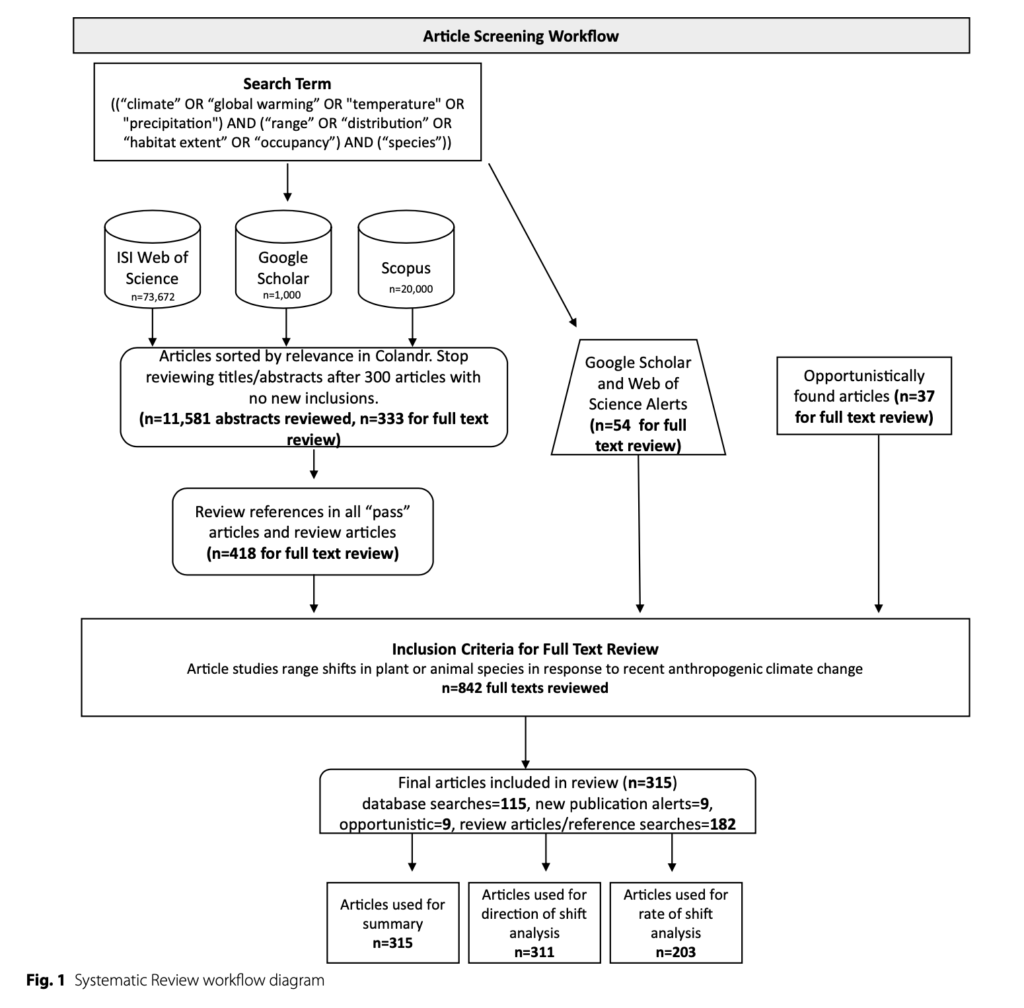Species Range Shifts Are Not as Simple as You Think

A new article that includes SE CASC Research Ecologists, Mitchell Eaton and Adam Terando as co-authors, Climate change and the global redistribution of biodiversity: substantial variation in empirical support for expected range shifts, was recently published in the journal Environmental Evidence. Researchers across the CASC network are co-authors to the paper. Read a summary by the National CASC.
The unprecedented pace of climate change is leading to a future fraught with uncertainty. Due to the large variability in biological responses to climate change, impacts to flora and fauna remain uncertain thus inhibiting effective planning and decision making for conservation and natural resource management. Commonly articulated hypotheses from scientific literature indicate that species will shift their spatial distribution as a means of adapting to a warming climate. These predictions argue that species will shift their distributions to higher latitudes, greater elevations, and deeper depths to maintain their temperature niche and also shift in various ways to maintain their precipitation niche. However, many species are not tracking these expected range shifts.
The Association of Fish and Wildlife Agencies identified the needs of coastal and marine natural resource managers for information on range shifts in order to adjust wildlife and habitat management. In order to meet this need, a systematic review was conducted by USGS Climate Adaptation Science Center scientists and university researchers to develop an assessment of the evidence for range shift expectations associated with climate change for plants and animals across terrestrial, freshwater, and marine ecosystems. Researchers explored the overall direction and magnitude of species range shifts across various taxonomic groups to prove whether expected range shifts are supported by empirical evidence.
The systematic review performed by researchers involved searching two online databases, Web of Science and Scopus, and the online search engine Google Scholar. Studies were screened based on their title/abstract and their full text to determine if they met defined eligibility criteria based on the PECO (Population, Exposure, Comparator, Outcome) question framework. They explored population of interest, climate change variables, baseline temperature and precipitation conditions, and measures of species range shift in geographic distribution. Logistic regression models were used to assess observed species range shifts aligned with the common expectations. The magnitude of shifts for the available range-shift data was identified in terms of distance/time, such as km/decade. This intensive review allowed the researchers to determine if most species are shifting in the direction expected and to identify the average rate of range shifts. See Figure 1.

Results from this systematic review revealed that less than half of all range-shift observations occurred in the direction expected (i.e. shifts to higher latitudes, higher elevations, and deeper marine depth). For studies covering range shift rates, species demonstrated an average rate of 11.8 km/decade toward higher latitudes and an average rate of 9 m/decade toward higher elevations. However, there was no significant evidence to support shifts for greater marine depths. Methodological factors in individual range shifts had a significant impact on the reported direction and magnitude of shifts. Variations in range shifts were apparent across dimensions, parameters, and taxonomic groups. Dimensions include latitude, elevation, longitude, and depth. Parameters include center-of-range, leading edge, trailing edge, and longitudinal shift. For example, there was greater support for latitude and elevation shifts than marine depth, leading edge (poleward/upslope) shifts occurred faster than trailing edge (equatorial/downslope) shifts for latitude, and insects experienced faster latitudinal shifts when compared to plants.
Despite the general expectation that species’ spatial distributions will shift to higher latitudes, higher elevations, and greater marine depths as a result of climate change, substantial variation exists that infringes on the accuracy of these hypotheses. On average, range shift rates exemplify significant movement to higher elevations and latitudes for many taxa. However, many species are not shifting in expected directions. Other processes, such as changing temperature and precipitation patterns along with land-use change and habitat loss, are contributing to the global redistribution of biodiversity. While the Earth has warmed at a large scale, the complexities of local climate change support the argument that localized range-shift directions will not always be oriented poleward, upward, or bottomward.
When assessing the confidence of range-shift hypotheses, variations in dimensions, parameters, and taxonomic groups must be considered along with variations in methodological factors. To help coastal and marine natural resource managers effectively prepare for species redistribution, it is important to determine which species will shift their spatial distribution and by how much. Data from this research can be used in future studies to explore additional hypotheses into species range shifts. By developing a thorough understanding of species range shifts, resource managers can effectively prepare for the subsequent effects on biodiversity conservation, ecosystem function, and human health and well-being.
The study, “Climate change and the global redistribution of biodiversity: substantial variation in empirical support for expected range shifts,” was published online April 11, 2023, in Environmental Evidence. Authors are Madeleine A. Rubenstein, Sarah R. Weiskopf, Romain Bertrand, Shawn L. Carter, Lise Comte, Mitchell J. Eaton, Ciara G. Johnson, Jonathan Lenoir, Abigail J. Lynch, Brian W. Miller, Toni Lyn Morelli, Mari Angel Rodriguez, Adam Terando, Laura M. Thompson.
-fontana-
Note to Editors: The study abstract follows.
“Climate change and the global redistribution of biodiversity: substantial variation in empirical support for expected range shifts”
Authors: Madeleine A. Rubenstein, Sarah R. Weiskopf, Romain Bertrand, Shawn L. Carter, Lise Comte, Mitchell J. Eaton, Ciara G. Johnson, Jonathan Lenoir, Abigail J. Lynch, Brian W. Miller, Toni Lyn Morelli, Mari Angel Rodriguez, Adam Terando, Laura M. Thompson.
DOI: https://doi.org/10.1186/s13750-023-00296-0
Abstract: Among the most widely predicted climate change-related impacts to biodiversity are geographic range shifts, whereby species shift their spatial distribution to track their climate niches. A series of commonly articulated hypotheses have emerged in the scientific literature suggesting species are expected to shift their distributions to higher latitudes, greater elevations, and deeper depths in response to rising temperatures associated with climate change. Yet, many species are not demonstrating range shifts consistent with these expectations. Here, we evaluate the impact of anthropogenic climate change (specifically, changes in temperature and precipitation) on species’ ranges, and assess whether expected range shifts are supported by the body of empirical evidence.
